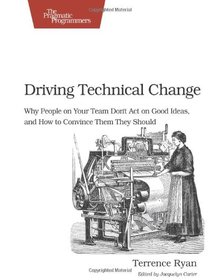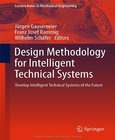Driving Technical Change

Book Details:
| Publisher: | Pragmatic Bookshelf |
| Series: | Pragmatic Bookshelf |
| Author: | Terrence Ryan |
| Edition: | 1 |
| ISBN-10: | 1934356603 |
| ISBN-13: | 9781934356609 |
| Pages: | 200 |
| Published: | Dec 07 2010 |
| Posted: | Jun 12 2017 |
| Language: | English |
| Book format: | |
| Book size: | 2.56 MB |
Book Description:
Your co-workers' resistance to new technologies can be baffling. Logical arguments can fail. If you don't do politics, you will fail. With Driving Technical Change, by Terrence Ryan, you'll learn to read users' "patterns of resistance"-and then dismantle their objections. Every developer must master the art of evangelizing. With these techniques and strategies, you'll help your organization adopt your solutions-without selling your soul to organizational politics.Finding cool languages, tools, or development techniques is easy-new ones are popping up every day. Convincing co-workers to adopt them is the hard part. The problem is political, and in political fights, logic doesn't win for logic's sake. Hard evidence of a superior solution is not enough. But that reality can be tough for programmers to overcome. In Driving Technical Change: Why People On Your Team Don't Act on Good Ideas, and How to Convince Them They Should, Adobe software evangelist Terrence Ryan breaks down the patterns and types of resistance technologists face in many organizations. You'll get a rich understanding of what blocks users from accepting your solutions. From that, you'll get techniques for dismantling their objections-without becoming some kind of technocratic Machiavelli.In Part I, Ryan clearly defines the problem. Then in Part II, he presents "resistance patterns"-there's a pattern for each type of person resisting your technology, from The Uninformed to The Herd, The Cynic, The Burned, The Time Crunched, The Boss, and The Irrational. In Part III, Ryan shares his battle-tested techniques for overcoming users' objections. These build on expertise, communication, compromise, trust, publicity, and similar factors. In Part IV, Ryan reveals strategies that put it all together-the patterns of resistance and the techniques for winning buy-in. This is the art of organizational politics. In the end, change is a two-way street: In order to get your co-workers to stretch their technical skills, you'll have to stretch your soft skills. This book will help you make that stretch without compromising your resistance to playing politics. You can overcome resistance-however illogical-in a logical way.
Download Link:
Related Books:
Technical Writing 101
A Real-World Guide to Planning and Writing Technical Documentation
2nd Edition
To succeed in technical writing, you need a lot more than just writing ability. Technical Writing 101 details the skills you need as a technical writer, and it explains how to handle the pressures of tight deadlines and ever-changing product specifications. This valuable reference also describes the entire documentation processplanning, writing, editing, indexing, and production. This updated second edition features the latest information on single sourcing and a new chapter on how trends in structured authoring and Extensible Markup Language (XML) affect technical writers....
SAE and the Evolved Packet Core
Driving the Mobile Broadband Revolution
This book provides a clear, concise, complete and authoritative introduction to System Architecture Evolution (SAE) standardization work and its main outcome: the Evolved Packet Core (EPC), including potential services and operational scenarios.After providing an insightful overview of SAE's historical development, the book gives detailed explanations of the EPC architecture and key concepts as an introduction. In-depth technical descriptions of EPC follow, including thorough functional accounts of the different components of EPC, protocols, network entities and procedures. Case studies of deployment scenarios show how the functions described within EPC are placed within a live network context, while a description of the services that are predicted t...
Design Methodology for Intelligent Technical Systems
Develop Intelligent Technical Systems of the Future
Intelligent technical systems, which combine mechanical, electrical and software engineering with control engineering and advanced mathematics, go far beyond the state of the art in mechatronics and open up fascinating perspectives. Among these systems are so-called self-optimizing systems, which are able to adapt their behavior autonomously and flexibly to changing operating conditions. Self-optimizing systems create high value for example in terms of energy and resource efficiency as well as reliability. The Collaborative Research Center 614 "Self-optimizing Concepts and Structures in Mechanical Engineering" pursued the long-term aim to open up the active paradigm of self-optimization for mechanical engineering and to enable others to dev...
2007 - 2021 © eBooks-IT.org



